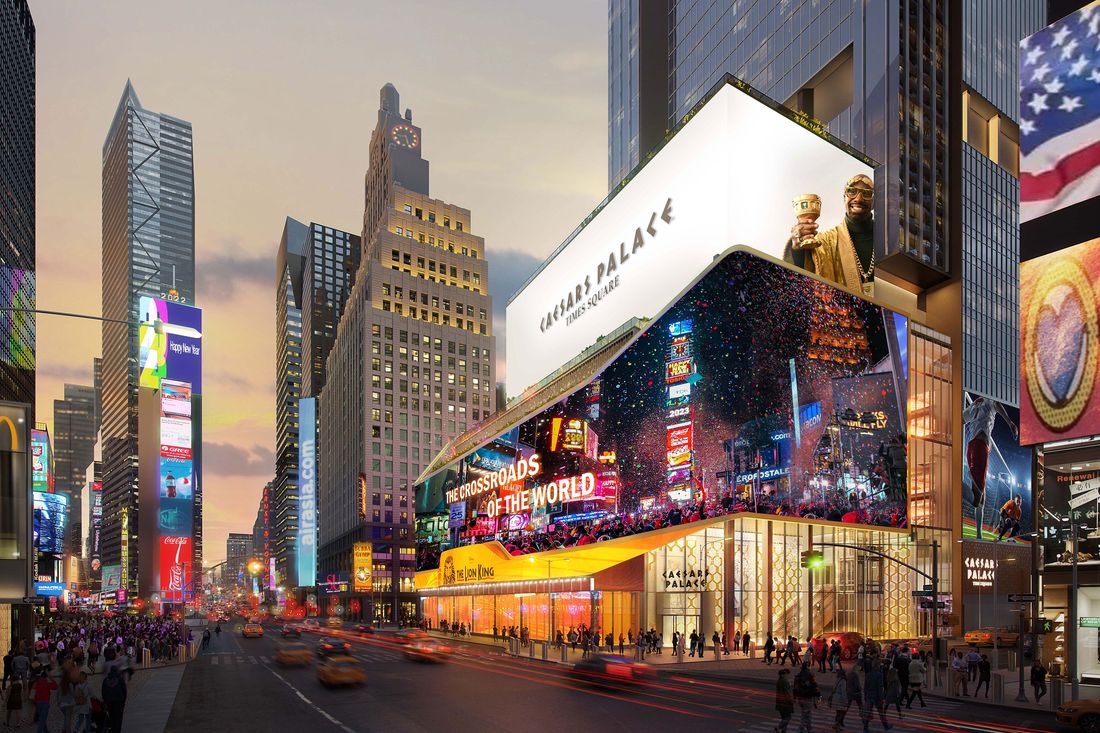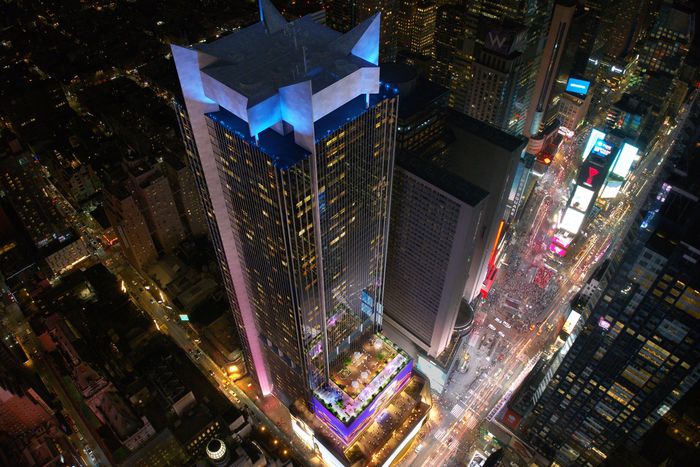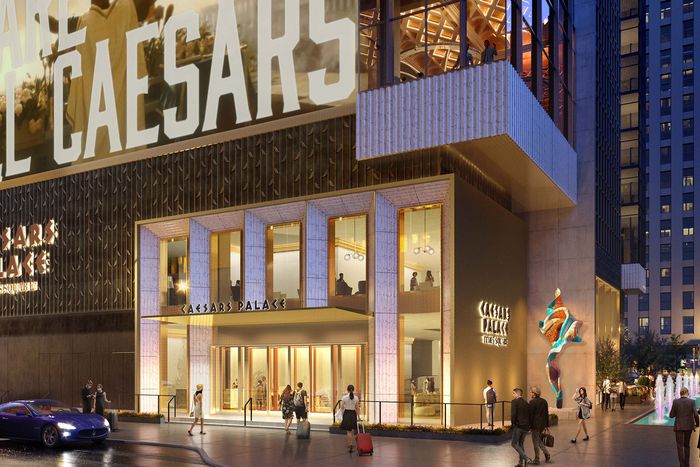
When I heard about the Times Square casino proposal, I was shocked that anyone would want to drop a casino at the exact spot where Broadway crosses Seventh Avenue, a.k.a. “the Bowtie.” It’s already a locus of sensory overstimulation, integral to New York City’s brand, with the sort of buzz casinos are generally built to gin up. In other places, such as Biloxi, Detroit, and Philadelphia, the presence of one or more casinos signals a city scrambling for quick and easy funds, a city that has lost a sense of itself. That’s not something that could happen to New York, is it?
The Times Square casino proposed by Caesars Entertainment, Jay-Z’s Roc Nation, and SL Green, New York City’s largest commercial landlord, would be a Caesars Palace — a name better associated with Las Vegas than the brightest stretch of Broadway. It’s one of many projects competing for the three gaming licenses that will be allotted by the State of New York to the metropolitan area. Other possible sites include Hudson Yards, Coney Island, Citi Field–Willets Point, and Aqueduct Raceway, and the odds are high there will be at least one in the five boroughs. For now, we will have to wait; all of the proposals were submitted on January 6 and a committee of local officials will convene and likely announce their choices later this year.
SL Green, as it happens, is the owner of the 1960s office tower in Times Square that it’s proposing to convert into an eight-story casino with hotel rooms above it. 1515 Broadway, originally named One Astor Plaza (after the landmark Beaux Arts Astor Hotel that was demolished to make way for it) is now known as the Viacom building; most famously, it was the home of the MTV studio from which Total Request Live was broadcast for a decade. On the ground floor is the Minskoff Theatre, where The Lion King will continue to be performed for the foreseeable future, and the casino floors will be located upstairs in the building’s podium.
The Caesars Palace proposal is something at which the Theater District excels: a revival. It’s the latest variation on saving Times Square from itself, a perennial theme. As a recent New York Post article framed it, “The 1515 Broadway project is needed to help arrest a slow, gradual decline in the district’s fortunes.”
It’s fitting that 1515 Broadway, designed by architect Der Scutt (who later designed Trump Tower), was the leading edge of a ’60s push to reinvent Times Square. Such efforts, intended to eliminate the vices for which the area had become infamous — pornography, prostitution, drugs — and replace it with white-collar jobs and more wholesome activities, continued for decades.
The never-ending push to reinvent Times Square as an office-tower district turned out differently than anticipated by both proponents and critics. In the 1980s, a plan to turn Times Square into an unremarkable extension of midtown — or, as political theorist Marshall Berman put it, “Rockefeller Center South” — featured four terrifyingly sober office towers designed by Philip Johnson and John Burgee (and, maybe, a giant apple sculpture by Robert Venturi). That version was undone by the 1987 stock-market crash and reemerged in the late 1990s. By then, Empire State Development, the organization in charge of reinventing Times Square, had wised up and issued design controls that required new buildings to be covered with “glitzy, bright lights.” In other words, what was taking place within Times Square’s walls mattered less than its signature exterior glow. Four office towers, bulkier than those proposed in the 1980s, were completed by the early aughts, but the camouflage — bigger, brighter, and more hypnotic — made Times Square even more of a tourist draw, and the ad-covered façades became a significant revenue stream for developers.
Speaking with Brett Herschenfeld, executive vice-president of retail and opportunistic investments for SL Green, I got a strong sense of déjà vu. The megaglitz is no longer enough; Times Square once again needs saving. He contends that the post-COVID crime wave is “very real in Times Square. It is a rugged place right now.” For SL Green, he says, the problem is that national retailers such as Oakley or Toys ’R’ Us have dried up. “And guess what’s coming back? Popeyes Chicken, Raising Cane chicken, Jollibee chicken, the ‘I Heart New York’ gifts.” In his pitch, the casino is an antidote to the so-called retail apocalypse, which was well underway by the time COVID hit (Toys ’R’ Us exited Times Square in 2015) and was accelerated by the pandemic. He didn’t seem to see any irony in positioning gambling as the thing that will banish lowlifes (and fast-food chains) from Times Square and attract a better class of tourists.
The Broadway League, which represents hundreds of theater owners, operators, and producers, sees the casino as a much more existential threat. A letter from League president Charlotte St. Martin to the membership argues, “Whether they come for a day or a week, visitors to Times Square come on limited budgets that would be cannibalized by casino gambling. Every dollar spent at the craps table, roulette wheel or slot machine is a dollar not spent on a play, dinner, or a souvenir.”
Herschenfeld counters that the facility will instead produce a “halo effect.” He says that a relatively small casino — without the capacity to meet all the dining, lodging, and entertainment needs of its customers — will dispatch them to surrounding stores and restaurants and drive 400,000 new bodies to seats in Broadway theaters annually. Vouchers for local businesses will encourage gamblers to occasionally leave the building and even use mass transit. “Take the subway,” he says, “and you get a reward.”
What Herschenfeld describes is an exceptionally virtuous casino. Its halo would, in theory, include $117 million in funding that would go to, among other things, theater tickets for kids in underserved communities, “mental-health awareness” for members of Broadway unions, and education for future performers and stagehands. The casino would also bankroll classy outdoor entertainment planned and staged by none other than Jay-Z. “Quality stuff,” Herschenfeld said. “Not just Elmos walking around anymore.” He added, “If we do it that way, New Yorkers will want to return to Times Square.” The union for Broadway actors and stage managers seems to agree. Actors’ Equity Association communications director David Levy says his union regards the casino partners as “good neighbors and collaborators” and praised their efforts to “understand the ecosystem they’re entering.”
But other theater organizations aren’t convinced. “There is no shortage of stagehands that would necessitate building a casino,” said Michael Wekselblatt, president of Local One of the International Alliance of Theatrical Stage Employees. He doesn’t believe the philanthropy will make up for the casino’s impact on the Theater District: “$117 million sounds nice, but I believe the actual physical impact on the area, and what it will do to the surrounding structures and theaters, is the real rift.”
Thinking about it, I’m surprised to realize I like the idea of reusing an office tower as a casino. While I’d prefer that obsolete office towers be converted to affordable housing, it seems cruel to make anyone spend more than a night or two in this hyperraucous spot, and recycling an existing building is clearly more sustainable than erecting a whole new faux Parthenon or work of starchitecture.
Looking at past efforts to tame Times Square, it seems even the biggest corporations and developments were unable to screw it up entirely. Back in the late 1990s and early aughts, when those four office towers in the plan overseen by the state’s Urban Development Corporation (now Empire State Development) were finally being built and bedecked with more and better signage, the Walt Disney Company was busy refurbishing the New Amsterdam, an ornate 1903 theater that once housed the Ziegfeld Follies, and making plans for a huge retail store right at 42nd Street and Seventh Avenue. It was widely believed that the Magic Kingdom was going to steamroll our city’s tawdry heart with its saccharine corporate branding. In short, Times Square would be Disney-fied.
But that didn’t exactly happen. In fact, I forgot all about the concept of Disney-fication until 2015, when the desnudas, women clad in body paint and not much else, showed up in Times Square (which had, by then, become largely pedestrianized courtesy of the Bloomberg administration) and made a living by posing for photos with tourists. It was a flashback to the bad old days and a major tabloid scandal, albeit one that thrilled me because it suggested that Times Square could absorb Disney’s best efforts and remain stubbornly anarchic.
But the casino could be more of a Disnifier than Disney ever was because, like the Magic Kingdom, Caesars (and every casino) has a deep interest in controlling its environment — not just the gaming floor but also the streets outside. A significant part of the casino’s sales pitch is a promise to bring heightened security to Times Square. Of course, the district is already a security-intensive place with concrete bollards everywhere to protect pedestrians and buildings from maniacs and terrorists, and it’s patrolled by “public-safety officers” privately funded by the Times Square Alliance. No doubt there are security cameras galore. (The Alliance supposedly has 18 building-mounted cameras in the area to automate its daily pedestrian counts.) But a casino’s presence would, it seems, call for much, much more.
The security consultant for the SL Green–headed project is none other than former New York City police commissioner William Bratton. The last time I heard Bratton weigh in on Times Square was during the desnudas controversy, speaking as Mayor Bill de Blasio’s police commissioner. In a radio interview, Bratton argued that the way to remove the painted ladies and other street performers was to get rid of the pedestrianized stretch of Broadway. “I’d prefer to just dig the whole damn thing up and put it back the way it was,” Bratton remarked. It made me think Bratton was the last person you’d want overseeing any aspect of Times Square.
Herschenfeld pointed out that, across town at SL Green’s newly constructed One Vanderbilt, an office tower next door to Grand Central, the pedestrian plaza is staffed by a private security team and thus feels exceptionally safe and is very clean. It is also one of those places that is more compelling in architects’ renderings than in life. A line of five round planters containing young honey-locust trees is the plaza’s key feature, and while passersby often rest on the concrete edges of the planters, they’re too low to the ground to be comfortable for long, so no one is tempted to linger. There, too, Bratton is the security consultant.
In late December, Bratton penned an opinion piece for the Daily News. Headline: “A casino will make Times Square safer.” “If left unchecked, persistent crime will become a drain on the neighborhood’s economic vitality,” Bratton wrote. “But this is far from a hopeless situation.”
Why? One New York Times story lists some of Bratton’s plans: “More than 50 new artificial intelligence camera systems ‘strategically placed throughout Times Square, each capable of monitoring 85,000+ people per day.’” Other reports mention surveillance drones. In total, SL Green and its partners plan to invest $85 million in security measures covering “a wide area from 40th St. to 53rd St. between Sixth and Eighth Ave.,” as Bratton wrote in the Daily News. That’s a very big halo. Bratton drops a hint as to what these measures might be: “The methods and technology already exist to stop crime before it happens.”
Most of us are inured, at this point, to having our every move tracked by our own devices or someone else’s. In Las Vegas, for example, surveillance is routinely used inside casinos to prevent card counting at the blackjack tables and other forms of cheating and to closely monitor the Strip for unsavory activity. Some casinos even use a facial-recognition software developed by an Israeli company for use on the borders of the West Bank to keep known cheaters and other personae non grata off the premises.
Right here, in New York City, we can see it being deployed in extreme and arbitrary ways, as James Dolan, CEO and chairman of MSG Entertainment — which owns Madison Square Garden, Radio City Music Hall, and the Beacon Theatre — deploys facial-recognition software to banish his perceived corporate enemies from his venues. They included an attorney escorting her 9-year-old daughter’s Girl Scout troop to the Christmas Spectacular at Radio City, who was denied entry for being involved in litigation against MSG.
Despite the proliferation of surveillance cameras and systems in public spaces, they have yet to prove they can effectively prevent crime. Some studies show they can prevent property crimes, like burglary, but not violent crime. And, finally, there is no telling what will happen with the surveillance data that will be collected around the clock or how it could be abused or manipulated by companies or law-enforcement agencies. The beauty of Times Square, even today, is that it remains an engine of cacophony and, despite endless makeovers, stubbornly unruly. It’s a place where you can still be anonymous and lost in the crowd. But this refuge of the unmediated masses could finally be tamed by a vast apparatus of cameras and other security devices installed to insulate a casino from the types of people and activities it deems undesirable. And I would hate, after tracking decades of failed attempts, to see anything — a casino, no less — succeed at saving Times Square from itself.







